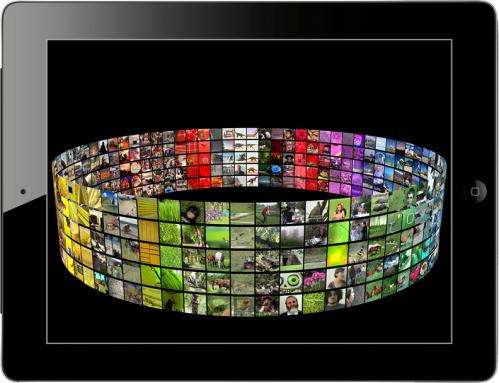Image searches are improved by 3-D presentation

Most image and video search engines list their results two-dimensionally. Researchers at the AAU have discovered that the search performance is more satisfying, if the results are displayed using a 3-D interface.
Searching for images using traditional search engines frequently leads to unsatisfactory results: tiny thumbnail images are displayed in a long list. Going through the entire list from top to bottom can often test the user's patience, and ultimately, the required image frequently remains undiscovered. The disadvantages become particularly apparent during interactive searches in large collections of images or videos.
In a recent article, Klaus Schöffmann (Institute of Information Technology), David Ahlström (Institute of Informatics Systems) and Marco A. Hudelist (Institute of Information Technology) presented an alternative display format, which helps to overcome these disadvantages: a 3-D ring or a 3-D sphere allow better search functionality. The researchers conducted four separate user studies and successfully demonstrated that the proposed 3-D interfaces facilitated significantly faster search performances for image material on desktop computers and tablets. The subjective assessment by users also improved. In the case of smartphones with a 3.5-inch display, the research team discovered that improvements only became noticeable when collections contained more than 200 images.
Schöffmann believes that the future of image and video searches lies in 3-D presentation: "Thanks to smart phones and tablets, users are creating an increasing number of photos and videos, for private use as well, which they want to access again at a later date. In most cases, they do not attach their own key words, which would simplify a subsequent search for the data. Relying simply on the automatically stored information regarding time and place is not usually very helpful in the search for photos. The 3-D presentation with colour sorting helps users to limit the search range quickly and efficiently. The chosen interface also allows the simultaneous display of large amounts of data, while keeping one particular area in focus, which reduces the mental demands upon the users."
More information: Schöffmann, K., Ahlström, D. & Hudelist, M.A. (2014). "3-D Interfaces to Improve the Performance of Visual Known-Item Search." IEEE Transactions on Multimedia 16(7), 1942-1951. ieeexplore.ieee.org/xpl/articl … number=6845325&tag=1
Provided by Universität Klagenfurt



















